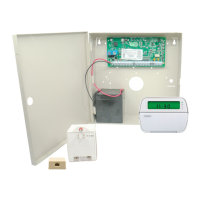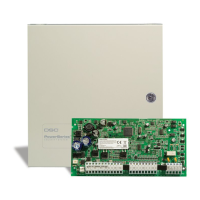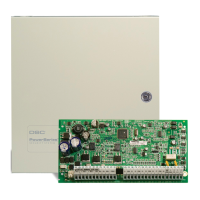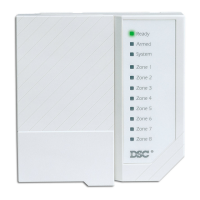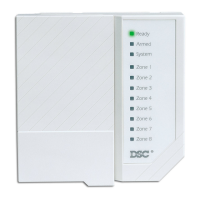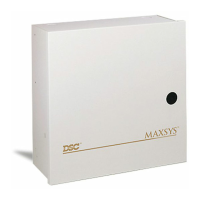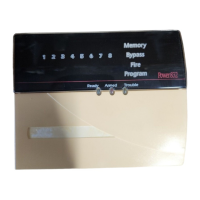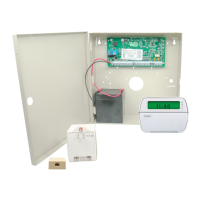
Do you have a question about the DSC PC1616 and is the answer not in the manual?
| Zones | 6 on-board, expandable to 16 |
|---|---|
| Partitions | 2 |
| User Codes | 48 |
| Event Buffer | 500 events |
| Keypads | Up to 8 |
| Power Supply | 16.5 VAC, 40VA |
| Communication | PSTN |
| Power Requirements | 16.5 VAC, 40VA |
| Battery Backup | 12VDC, 7AH |
| Operating Temperature | 0°C to 49°C |
| Humidity | 5% to 93% RH, non-condensing |
| Wireless Zones | Up to 16 (with wireless receiver) |
Guidance on placement and installation of smoke detection devices.
Guidance on placement and installation of carbon monoxide detection devices.
Describes the 4-wire communication connection for modules.
Explains wiring for normally open/closed contacts with SEOL/DEOL resistors.
Details adding zones using expander modules and jumper settings.
Explains bell output voltage and wiring for alarms.
Details using the AUX output for powering modules and detectors.
Describes how PGMs switch to ground when activated.
Explains wiring for 4-wire CO detectors and DSC wireless CO detectors.
Details wiring telephone connections to an RJ-31x connector.
Instructions for proper grounding of the control panel.
Guide to maximum loads and standby times for battery backup.
Specifies primary and secondary AC wiring requirements.
Step-by-step guide for enrolling wireless devices.
How to arm the system in Away mode.
How to arm the system in Stay mode.
Procedure for disarming the system.
Lists and describes keypad commands starting with '*'.
Explains the use of programmable one-touch function buttons.
Using pre-defined templates for quick system setup.
Setting up local and remote programming via DLS software.
Entering installer programming and understanding status lights.
Arming all partitions in Stay mode with a single command.
Arming all partitions in Away mode with a single command.
Disarming all partitions with a single command.
Assigning operational characteristics to zones.
Programming entry and exit delay times for partitions.
Setting or changing the installer access code.
Setting or changing the master user access code.
Setting or changing the maintenance user access code.
Programming the behavior of Programmable Output Modules.
Configuring general system options.
Configuring bell squawk and exit/entry delay options.
Configuring keypad functions and TLM options.
Configuring AC trouble display and keypad blanking options.
Configuring wireless key usage and RF jam detection.
Configuring test transmissions and cross zoning.
Configuring LED indicators and user access to menus.
Assigning zones to specific keypads.
Configuring access code entry during entry delay.
Configuring access code requirements for menus.
Configuring fire key behavior and trouble beep options.
Setting the loop response time for zones.
Customizing zone operations like audible alarms and bypass.
Setting the number of attempts before a FTC trouble.
Time panel waits for handshake after dialing.
Time panel waits for acknowledgment from modules.
Programming DST adjustments.
Programming standard time adjustments.
Setting the duration for PGM output activation.
Setting how long a tamper condition latches a PGM output.
Setting the timer to postpone automatic arming.
Setting timers for cross zone or police code events.
Programming automatic arming times for each day.
Setting the duration of the pre-alert for no activity arming.
Setting the timer for no activity arming.
Setting the pre-alert timer for auto-arming features.
Enabling or disabling partitions.
Assigning zones to specific partitions.
Programming the primary telephone numbers for communication.
Programming the secondary telephone number.
Programming the tertiary telephone number.
Programming digits to disable call waiting.
Programming the system account number.
Programming account numbers for each partition.
Programming reporting codes for various events.
Selecting the communicator format for phone numbers.
Directing event reporting to specific phone numbers.
Setting variables like swinger shutdown and delays.
Programming the time for test transmissions.
Programming the time for periodic DLS calls.
Configuring options for the first communicator.
Configuring options for the second communicator.
Configuring options for the third communicator.
Configuring options for the fourth communicator.
Setting the timer for TL/GS module fault checks.
Configuring DLS downloading options.
Programming the phone number for the downloading computer.
Programming the access code for downloading.
Programming the panel identification code.
Setting the timer for double-call feature.
Setting the number of rings to answer for downloading.
Initiating downloading via PC-Link.
Customizing attributes for PGM outputs.
Assigning PGM outputs to specific partitions.
Programming additional reporting codes.
Programming automatic disarming schedules.
Programming auto-disarm holiday dates.
Adjusting the clock for minor corrections.
Configuring international options for the first phone line.
Configuring international options for the second phone line.
Setting the delay between dialing attempts.
Explains the Contact ID communication format.
Explains the SIA level 2 communication format.
How SIA format automatically generates zone/access code numbers.
Options for directing event reporting.
Reporting codes for opening and closing events.
Reporting codes for zone restorals.
Describes formats used for communication.
Details on the Contact ID format and its usage.
Details on the SIA Level 2 format and its usage.
Describes how to configure and use the pager format.
Explains different pulse format options for communication.
How the system supervises the telephone line for faults.
Guidelines for choosing an appropriate installation location.
Essential safety measures during the installation process.
Information on potential system failures and their causes.
Details of the product's warranty terms and conditions.
Legal disclaimers regarding product warranties.
Conditions under which the product warranty is voided.
Specific items not covered by the product warranty.
